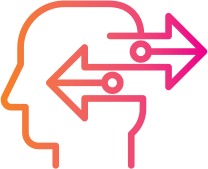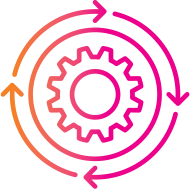For many companies, the pandemic accelerated digital transformation virtually overnight. New ways of working required the rapid introduction of new technologies. Undertrained and physically isolated employees overwhelmed IT help desks for the support they needed to get connected and be productive.
Help desk ticket volumes grew 35%, causing ticket backlogs, time to resolution, and support costs to grow. In the face of these pressures, employee (the help desk customer) satisfaction with help desk support dropped during the pandemic, from 83.3% to 74.7%.1
At the same time, without IT help desks, companies and their employees would not have been able to pivot as quickly to remote work to sustain business continuity. Even now, the work of IT help desks is far from over. More companies are embracing
hybrid work as their business model going forward. Employees returning to work a portion of the time need assistance in understanding and using technology that will allow them to shift seamlessly between the workplace and home, enabling them
to do their job no matter where they happen to be.
With companies’ greater reliance on technology to keep the workforce productive, they need high-functioning help desks to help employees resolve any issues with technology as quickly as possible. Companies can’t afford to have their employees experiencing long wait times for help, not getting their issues resolved satisfactorily, or having to call repeatedly on the same issue.
That’s why IT help desks should turn to conversational artificial intelligence (AI) to optimize the employee experience and help resolve issues more quickly to boost productivity and satisfaction.
Remove work causes help desk overload
With employees suddenly working from home during the pandemic, the IT help desk was overwhelmed with requests for assistance:2
- Monthly help desk ticket volumes increased 35%
- Time to handle a help desk ticket increased from 7.37 minutes to 9.54 minutes
- Mean time to resolution rose from 6.18 hours to 9.72
- Cost of a support ticket grew from $20.44 to $26.51
- Customer satisfaction decreased from 83.3% before the pandemic to 74.7%
- The backlog of unresolved tickets rose from 7.2 days to 12.1
- Job satisfaction among help desk staff decreased from 76.8% to 67.11%
Understanding and Optimizing Every IT Help Desk Conversation
Conversational AI is a set of advanced AI technologies that recognizes and comprehends human language and uses this understanding to optimize and analyze conversations in and across multiple channels. These technologies enable machines to understand human conversations as they are happening or after the fact from a recording.
Using a platform of conversational AI capabilities, IT help desks can automate and optimize the entire experience, from self-service to staff-assisted service to post-interaction analytics. Working together, conversational AI and automation capabilities drive a positive, productive IT help desk experience for employees and the IT help desk staff with:


AUTOMATED SELF-SERVICE
Automate common, repetitive inquiries with personalized self-service via an intelligent virtual assistant (IVA), across voice and web, to offload interactions while accelerating resolution. An IVA with conversational AI passes the context from your IVA to the IT help desk to create a frictionless interaction for employees that need further assistance. You can also automate servicing of IT service tickets, including password resets and unlock requests.

IN-CALL GUIDANCE
Conversational AI understands the employee’s real intent to help the IT help desk resolve issues faster. By understanding and analyzing employee context and intent, conversational AI assists the IT help desk staff through in-call coaching assistance and alerts, improving outcomes and enabling staff to handle a wider variety of requests.


AUTOMATED SERVICE TICKETS
With a conversational AI platform that listens and transcribes conversations in real time, it can automatically create, update, and complete a service ticket, freeing up time for IT help desk staff and improving accuracy. The AI platform should capture information and update a centralized service ticket regardless of the interaction channels (email, chat, or phone) that were used.


AUTOMATED WORKFLOW
Improve follow-through and reduce the amount of time IT help desk staff spend handling manual tasks after the interaction is complete by automating the after-call workflow. A conversational AI platform with automated commitment/follow-up management automatically identifies and performs tasks related to completing service tickets as well as other requirements.


DEEP INSIGHT FROM POST-INTERACTION ANALYTICS
Automate post-call analytics on 100% of IT help desk interactions to understand performance, effectiveness, case drivers and trends, outliers and anomalies impacting effectiveness, employee sentiment about product or software usage, and areas of friction in the employee experience. Help desks can also use conversational AI and interaction analytics to automatically monitor and score quality and provide feedback to staff and supervisors to drive performance improvements.
Reducing Quality Costs and Improving Visibility into Performance
One leading BPO company that provides IT help desk services with more than 2,000 people across 42 clients handles more than 57,000 calls daily. The company lacked the ability to monitor and analyze every call for quality. In fact, it was able to analyze fewer than 1% of calls being monitored. Despite this, quality auditing costs were high because the QA team needed to manually perform all audits using different audit criteria for different clients.
The BPO also lacked the deep visibility into performance it needed to drive better coaching, feedback, and training. Not having actionable insight into call drivers, problem types, staff knowledge, user impact, and other aspects of help desk interactions made improving metrics such as first-call resolution and employee satisfaction extremely difficult.
Using AI-powered interaction analytics, the BPO automated call monitoring, quality auditing, case categorization and management, and performance management. Automation reduced QA effort and costs, delivered visibility into performance as well as centralized and standardized performance scoring, and provided insights to drive coaching, feedback, and training to improve help desk metrics and performance against service level agreements (SLAs).
Half of businesses outsource the help desk function
Nearly half (49%) of all businesses keep their IT help desk function internal, with another 46% utilizing a balance of internal and external resources and 5% exclusively using third parties for the help desk function.3
Conclusion
As remote and hybrid work models continue to place additional stress and strain on IT help desks, it’s more critical than ever for companies to elevate the performance of the help desk and transform the experience for both employees and IT help desk staff.
Conversational AI can be the foundation for optimizing every IT help desk conversation to accelerate resolution, improve effectiveness, drive employee and IT help desk job satisfaction, improve performance, and sustain business productivity during business model changes.
- “Helpdesk Meltdown Due to Absenteeism, Low Morale and Increased Workload,”
Cliff Saran, ComputerWeekly, February 2021 - “Helpdesk Meltdown Due to Absenteeism, Low Morale and Increased Workload,”
Cliff Saran, ComputerWeekly, February 2021 - “The More Things Change, The More They Stay the Same: 2021 Help Desk Trends,”
Ashley Watters, CompTIA, April 2021
)